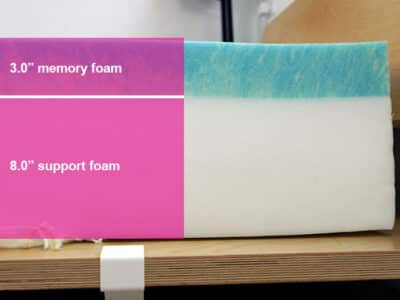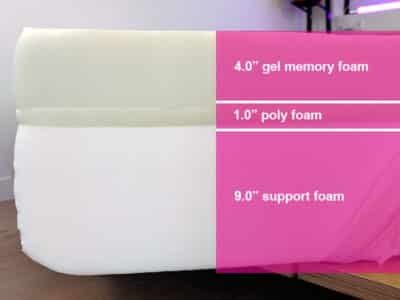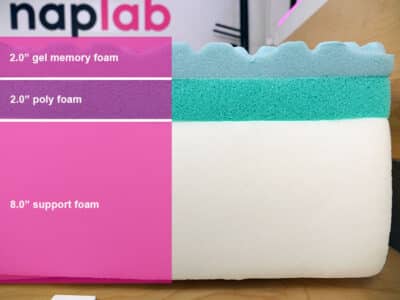
Gel Memory Foam

Memory Foam
Summary
Gel memory foam vs. memory foam mattresses—which is right for you? Both of these mattresses are made of memory foam and many similarities in terms of feel and performance.
Traditional memory foam oftentimes gets a bad rap for heat retention, deep contour, and delivering a “stuck feeling”. Gel memory foam was developed as a memory foam with gel infused for enhanced cooling.
But with modern developments, the line between gel memory foam and non-gel memory foam is narrowing. Assuming both foams are of high quality, performance differences can be minimal between these two materials.
Just because a memory foam has gel doesn’t mean it’s cool. By the same token, a memory foam without gel isn’t necessarily going to be a warmer foam. Higher quality memory foam, be it gel or non-gel, can deliver excellent overall performance and cooling.
In This Comparison
Best Models | Comparison | Memory Foam | Gel Memory Foam | Summary | FAQ
Best Gel Memory Foam Mattresses
| Mattress | Score | Read Review | Check Price |
|---|---|---|---|
| Ghostbed Luxe | 9.19 | Read Review | Check Price |
| BedInABox Original | 8.79 | Read Review | Check Price |
| Zoma | 8.89 | Read Review | Check Price |
| BedInABox Tranquillium | 8.67 | Read Review | Check Price |
| Ashley Sleep Gruve | 8.58 | Read Review | Check Price |
Best Memory Foam Mattresses
| Mattress | Score | Read Review | Check Price |
|---|---|---|---|
| Amerisleep AS3 | 8.99 | Read Review | Check Price |
| Novosbed | 8.87 | Read Review | Check Price |
| BedInABox Eco-Lux | 8.54 | Read Review | Check Price |
| Loom & Leaf | 8.81 | Read Review | Check Price |
Are Gel Memory Foam or Memory Foam mattresses better?
We conduct data-driven and objective tests for every mattress we review (see how we test here). Each mattress has 33 individual data points that are recorded and analyzed.
Among the 5 top performing memory foam mattresses, three are gel memory foam and two are non-gel memory foam mattresses.
These mattresses are mentioned above, but I’ll highlight them again here, ordered by overall performance score.
Top 5 Memory Foam Mattresses
| Rank | Mattress | Memory Foam Type | Score | Check Price |
|---|---|---|---|---|
| 1 | Ghostbed Luxe | Gel | 9.19 | Check Price |
| 2 | Novosbed | Memory Foam | 8.87 | Check Price |
| 3 | Amerisleep AS3 | Memory Foam | 8.99 | Check Price |
| 4 | BedInABox Original | Gel | 8.79 | Check Price |
| 5 | Zoma | Gel | 8.89 | Check Price |
What is a memory foam mattress?
As the name suggests, a memory foam mattress is any mattress where the comfort layers are made up mostly of memory foam.
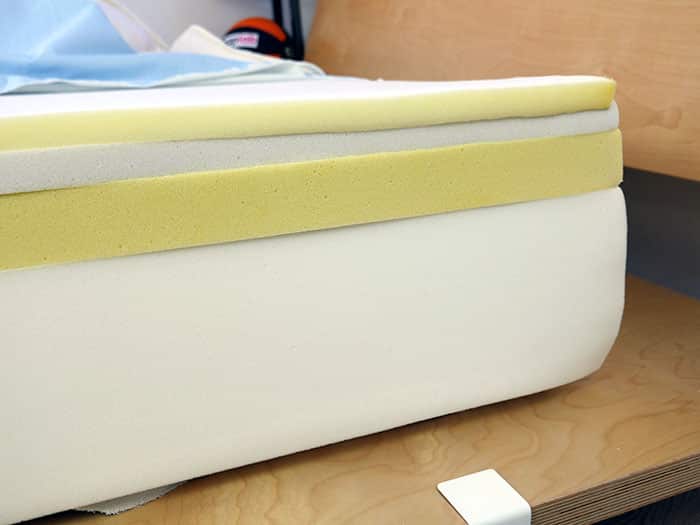
Deeper support layers may include a transitional poly foam or high-density support foam, but primarily, these mattresses have a distinct feel of memory foam.
What is memory foam?
Memory foam is a man-made foam created from the combination of polyurethane and other chemicals that create a high level of contour and hug as you lie on the mattress. You’ll sometimes see memory foam labeled as viscoelastic polyurethane foam.
It is the viscoelasticity that makes memory foam memory foam. That’s what gives it the unique hug and body contouring.
What does memory foam feel like?
Memory foam has a distinct feel that most sleepers will recognize when they lay on it. This kind of foam experiences a deeper level of hug and contour and is marked by its viscoelasticity.
Viscoelasticity is the stretch of memory foam and the property that allows the foam to return back to its original shape.

Think of a hand pressing into memory foam. When the hand is removed, the hand print (or memory) remains in the foam for a couple of seconds before the foam returns to its original state.
Advantages of Memory Foam
#1. Deeper Hug
Traditional memory foam often has a deeper hug and contour. This is especially beneficial for side sleepers since the foam can more easily follow the contour of your spine.

Support and pressure relief are improved in these scenarios since the weight is more evenly distributed along the surface of the mattress.
#2. Minimal Motion Transfer
Memory foam is also known for minimal motion transfer. It has a tendency to deaden energy, motion, and noise into the foam layers instead of reverberating that energy across the surface of the mattress.
This can be a real advantage for sensitive sleepers or those who are easily disturbed by partners who toss and turn.
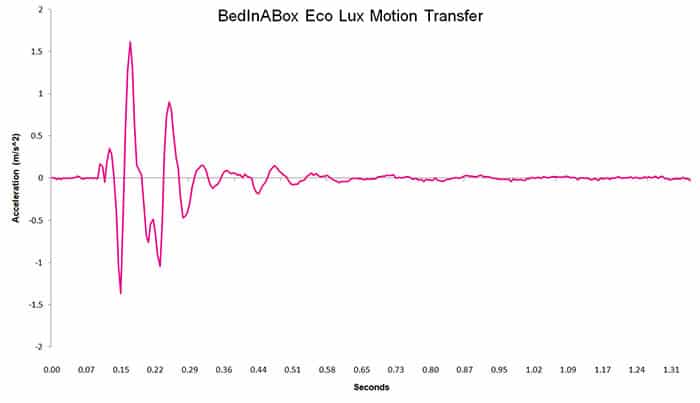
The chart above shows motion transfer in our test of the BedInABox Eco-Lux, an 11″ high memory foam mattress. As you can see, there is an initial energy spike from where the ball was dropped in our tests, but that energy dissipated very fast.

For comparison, here is a similar motion transfer chart on the Emma Hybrid, which uses memory foam and coils. As you can see, there’s a more significant energy spike and the energy continues to bounce across the mattress for over 1 full second.
Disadvantages of Memory Foam
#1. Heat Retention
The most well-known disadvantage of traditional memory foam is heat retention and poor cooling performance. The deeper contour and denser cell structure of memory foam generally allow for less airflow and a “stuck” feeling.
The cooling video above shows heat retention on the SweetNight Dreamy memory foam mattress, one of the warmest memory foam mattresses that we’ve tested to date.
That being said, many memory foams add special features to their foams to counteract heat retention and they are largely successful.
Memory foam can be enhanced with:
Including these additives in the make-up of the foam improves performance on many levels and helps to negate some of the disadvantages of traditional memory foam.
In addition to additives, memory foam can also have an altered shape to improve performance. Some of the most common structures include:
#2. Poorer Edge Support
Memory foam can sometimes create worse edge support as foam tends to allow for more compression.
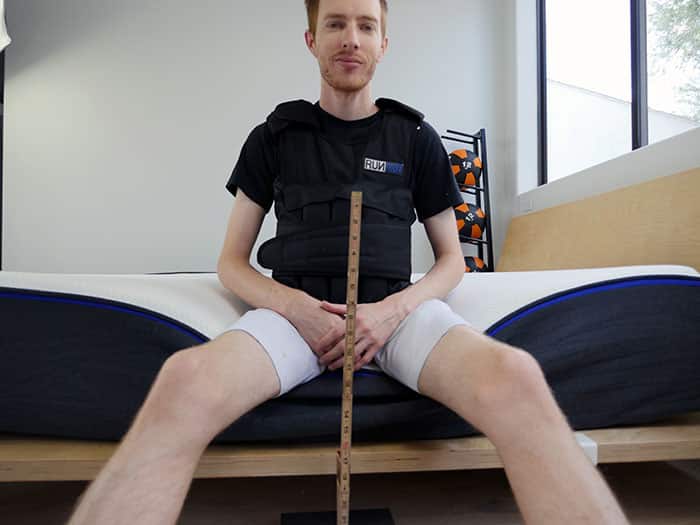
Among all memory foam mattresses we’ve tested to date we do see a range of performance. Even though many memory foam mattresses struggle in this area, not all do.
Both the BedInABox Eco-Lux as well as the Novosbed mattress all had excellent edge performance with scores in the mid to upper 9’s out of 10.
What is a gel memory foam mattress?
A gel memory foam mattress is also 100% foam, like the traditional memory foam mattresses, but at least one layer contains a gel foam.
Enhancing memory foam with gel is a popular way to improve cooling.
What is gel memory foam?
Gel memory foam can be defined in a couple of different ways. Gel can be infused / swirled within the memory foam, like we see below.

It can also be infused with gel beads that are suspended within the memory foam. This strategy has a similar effect to the swirled technique, even though aesthetically it looks different.

Some mattresses have a layer of exclusive gel material that sits on top of memory foam likes. The Loom and Leaf is a prominent mattress that employs this method.

When it comes to gel, the quantity is the most important factor. The more gel, the more significant the potential cooling benefits. As a result, a solid gel layer (like the one on Loom & Leaf) is going to offer better performance than just a few gel beds mixed into a foam layer.
What does a gel memory foam mattress feel like?
Gel memory foam feels very similar to memory foam in terms of deeper contour, hug, and viscoelastic properties.
It retains the “memory” aspects of popular memory foam, but the gel helps to improve cooling and prevents sleepers from getting too warm.
Gel Foam vs. Memory Foam
Because gel memory foam is so similar to traditional memory foam, the main advantages and disadvantages largely overlap. The one exception is cooling performance.

(while laying on the mattress)

(heat retained after 5 minutes)
In most cases, gel memory foam will have improved cooling performance over traditional memory foam.
But that’s not always the case and it’s important to note exceptions.
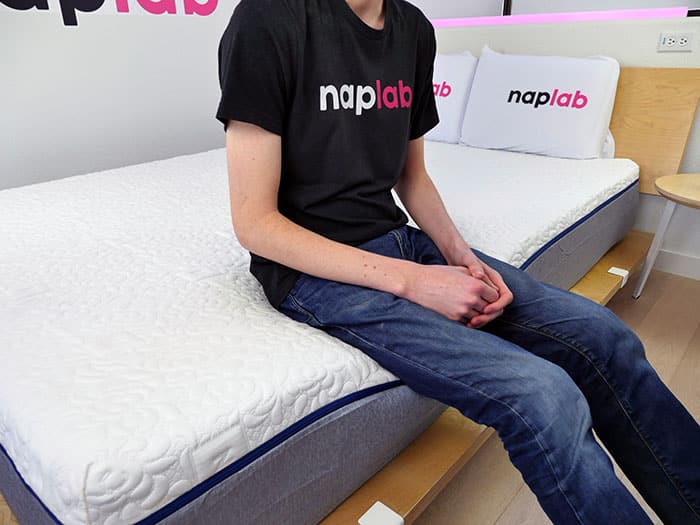
For example, a traditional memory foam mattress that uses convoluted foams, copper, graphite, or charcoal can all have performance levels matching that of gel memory foam.
Or even if memory foam does not contain these materials, it can still have design features that enhance performance without including any additional materials (ex: convoluted foam, perforated foam, channel foam, etc).
Which is right for you?
So you’ve made it this far… how do you know which mattress is right for you? The answer probably depends on a number of factors, beyond simply the use of gel or not.
The quality of the materials, mattress firmness, and other performance factors (ex: bounce, sinkage, response, etc) can all play a role in determining which mattress is right for you.
Still have questions?
We love talking about mattresses. A lot. If you’re not sure which mattress is best for your needs, take 5 minutes to take our mattress finder quiz.

This simple quiz contains important questions about your sleep and the answers go straight to a real person here at NapLab.
We’d love to help you find the right mattress, whether that be memory foam, gel memory foam, or something entirely different.
FAQ
Sometimes, but not always. Gel is often infused into memory foams to provide an enhanced version of traditional memory foam—keeping the best parts of memory foam but compensating for the disadvantages.
Yes. All memory foam is good for side sleepers and gel memory foam would fall into a similar category. Side sleepers benefit from memory foam because of its deeper contour and viscoelasticity. The gel provides the added benefit of cooler surface temperatures and limited heat retention.
No. Gel memory foam typically had the gel infused during the production of the foam, as it is transforming from the liquid state into the solid state. It’s like an ingredient in a cake. Once the foam has set, the single ingredient cannot easily be separated from the whole.
Traditional memory foam tends to be a little warm, but modern memory foam tackles this issue head on with a handful of different strategies including gel, copper, graphite, charcoal, or changes in the profile of the foal (ex: convoluted or perforated foam).
Memory foam mattresses, including gel memory foam can be expected to last 8-10 years. A hybrid memory foam mattress can sometimes have a longer lifespan, closer to 8-12 years, if well maintained.

